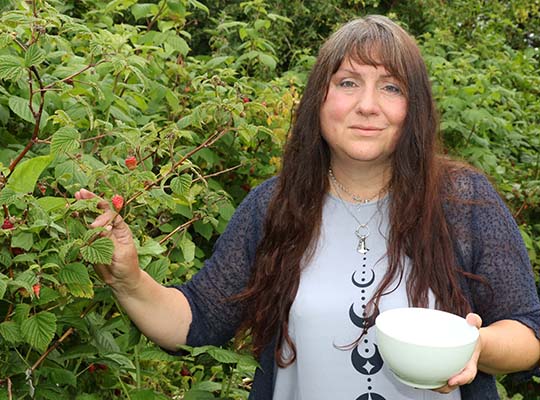Helen Hastings chats to forager Alison McGrenaghan about collecting berries in the wild and provides some tantalising recipes to make your tongue tingle.
Did anyone else view lockdown as a three month celebration of banana bread? I mean, don’t get me wrong, I love a nice bit of banana bread as much as the next person, but my social media accounts just about exploded with it.
Hey, what’s a world threatening virus when we have too many over ripe bananas!?

As a nation, we took to our kitchens; we mixed, chopped and drizzled our way through a crisis, a world horrifyingly humbled with what we all thought was some kind of Armageddon.
The gentle yet powerful nostalgia of a house filled with the scent of home baking acted as a bridge between normalcy and the terror we were being faced with on a daily basis.
I’m just going to say this right here, right now… I was scared, I was really, really scared. Walking into my local shop and seeing empty shelves and the blank horrified looks on the other shopper’s faces is a memory that still forms an ice cold lump in my stomach.
We had all been thrown into a spinning void of uncertainty and immediately started grieving for all our own versions of ‘normal’.
‘Normal’ very much came to the rescue for me, in the form of cooking (and probably far too many gin and tonics).
After a day of terror being exploded out of my television set and the scare mongering that felt like a punched gut, I would down tools and make for the kitchen.
The music would go on (normally a bit of Patti Smith shouting angrily about horses) and I would go all out with my trusty gin and tonic by my side.
This ritual not only healed my heart, but it healed the whole day. This burst of homely activity grounded me and for a few hours everything would be fine, not brilliant maybe, but fine. It put me in a place where I could cope.
If social media was a real person, then they would have serious issues with cholesterol by now and probably facing a diagnosis of type two diabetes, but they would die happy with a full belly and a full heart!
We packed our profiles to the rafters with our antics, creating a virtual cookery book of all that our grandmothers instilled in us and their grandmothers before them.
Our need to eat is of course survival in itself but during lockdown it became something else, it was also feeding our minds and our hearts.
The life breathing and primal instincts of food has saved our lives this last while not just physically but emotionally and we must never ever forget that.
Once more I talk to our expert forager Alison McGrenaghan about the primal joy of foraging for wild food and this month it’s all about the summer berries!
So grab your Factor Fifty (ok, ok so maybe I’m being a little optimistic but throw me a bone here) and come join us on a foraging trip!
***

Hi Alison, I think we should have the safety talk here first! Berries really can be quite treacherous as some very poisonous berries look so similar to the more edible variations (a bit like mushrooms!). So before we get into the more pleasurable side of foraging, let’s have your guidance on a safe foraging expedition.
When it comes to wild summer berries stick to the safe and easily identifiable ones – at this time of the year I would suggest bilberries, raspberries and strawberries. Each plant is pictured below so we can be doubly sure, but I would imagine most people would be fairly confident in recognising at least one or two of them.
Read up on them first if you are not feeling confident and remember to look at the whole plant and its habitat, not just the berry. Bring an identification information sheet or book with you, so you can double check the leaves, the size of the plant etc if you are not sure. If you are still not 100% certain, don’t pick the plant. As I have said before, if you are not feeling 100% about collecting wild food, it might be worth joining on to a foraging class or workshop to help you with identification and confidence.
We are now on the other side of the summer solstice when the summer fruits start becoming the most abundant. Have you noticed any changes this year with regards to nature and its harvest and if so, can any of it be linked to the lockdown and the general change in atmosphere of this year?
Hmmm…good question. I have noticed an abundance of raspberries and strawberries.
Also elderflowers have seemed to be bursting out everywhere in the last month. I think the weather has been key, with a long warm sunny period in Spring and early Summer, followed by a warm wet period in June and early July, it seems as though it has been perfect plant growing weather.
As far as the knock on benefits of lockdown on nature, I can’t prove anything and I haven’t seen any supporting evidence that claims it has had a positive effect on wild plants.
But it is tempting to make the connection between the lack of pollution and general human activity and the abundant hedgerows… and the clean air!
Right Alison, so let’s be having you! Give us your most tantalising recipes for summer berries and your favourite variations to work with.
All of these berries will make really incredible jam – and before your readers turn their noses up at the simplicity of that part of my answer, I mean really incredible jam, like a little mouthful of heaven!
There are endless recipes for jam out there, so I will let people research their own personal favourites.
The down side to jam is that you need a good amount of berries, so you can only really make it after a very successful forage.
Raspberry ice cream is another summer delight and it’s easy to make. Here is the recipe I use.
Raspberry Ice Cream
Ingredients
1 kg raspberries
200g sugar
500mls double cream
250mls single cream
2 teaspoons vanilla extract
Directions
Place raspberries in a blender; cover and pulse until chopped. Transfer to a large bowl; stir in sugar until dissolved. Stir in remaining ingredients until blended.
Pour mixture into the ice cream maker and churn. Keep a close eye on the ice cream during this process as in my experience it is an inexact art and sometimes it solidifies quicker than others.
Once ready, transfer ice cream to freezer containers, allowing headspace for expansion. Freeze 2-4 hours or until firm.
I have to say, it is my personal preference to skip that final freezer phase and to just enjoy the lush, soft, semi-frozen ice cream fresh from the churn.
Wild strawberries are delicate and they are not always hugely prolific, so I think the most enjoyable way to eat them is freshly picked with cream, Greek yoghurt or really good quality vanilla ice cream.
If you are lucky enough to know a good spot where you can gather wild strawberries in quantity, then you can make jam and ice cream as stated above, but also tarts, cordial and cakes.
Bilberry Flapjacks
Ingredients
250g butter
140g demerara sugar
85g golden syrup
400g oats
100g self-raising flour
The zest of one lemon
200g bilberries
Method
Heat oven to 160C/140C fan/gas 3. Line the bottom of a greased 20cm square baking tin with greaseproof paper.
Melt the butter, sugar, golden syrup and a pinch of salt, over a low heat. Combine the oats, lemon zest and flour in a large bowl and pour over the melted butter and sugar mixture. Mix together, then fold in the blueberries.
Put the mixture into the tin and squash down using the back of a spoon. Bake for 40-45 mins until golden brown. Leave in the tin to cool completely.
Lift the cooled flapjack onto a board. Leave to cool until set before cutting into squares.
In general soft fruits make lovely coulis, which can be served with a variety of desserts and treats such as cheesecake, ice cream and pancakes.
Fruit coulis
Place fruit in the bowl of a food processor, and pulse until smooth. Strain through a fine mesh sieve set over a bowl; discard solids. Add sugar as desired.
I watched a documentary recently in which a terminally ill woman was asked what got her through her more difficult days. She smiled the biggest smile and just said ‘FOOD! Food is life!’. What is it that you truly love about food and cooking? I know for me, it goes way beyond just filling your stomach. It gives me a sheer primal joy to cook and shop/forage for food.
Oh yes, 100%! Food is such a celebration of life and living. As I am sure you have heard me say before, we are all part of a universe which perpetually consumes itself. We eat from its abundance and in time we in turn will be consumed by it.
It’s a cycle and it is existence at its most profound and fundamental. When we grow food, forage and cook food and ultimately eat food, we engage in this process completely.
It assails all of the senses, not just the obvious taste and sight, but touch, smell and sound too.
Think of the pleasing crunch sound of an apple or raw carrot, I can’t imagine the experience would be quite so fulfilling if silent.
Or the smell of fresh lemon, or mint, or basil and who hasn’t come into the kitchen to be aroused by the apetizing smell of bread fresh from the oven.
We have all enjoyed the suede-like touch of peach skin, or the pure childlike joy of squelching jelly through your teeth.
Put these all together along with the creative process of cooking and to my mind you have the most successful attempt at alchemy that most of us will ever experience.
These are deep yet simple pleasures, which are of course always the best.
Hey, it will soon be plum season! Will you be making some of your (now) infamous plum wine, and what insurance companies are guaranteed to pay out for the aftermath?
Ha ha! Yes, my plum wine has been known to deliver quite a kick! Sadly my plum trees don’t promise much of a crop at all this year.
They tend to fruit heavily every other year and this is one of their off years.
I will be out foraging later in the season, so if I am lucky enough to gather sufficient plums or damsons, then there is every chance that plum wine will be back on production.
***


























